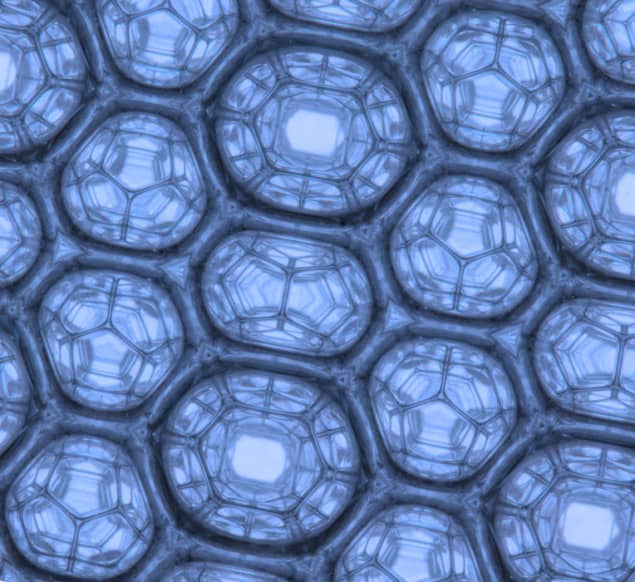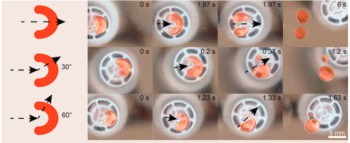
Whether it is the frothy milk on your cappuccino, the soapy suds in your bath or the large-scale structure of the universe, foams have intrigued physicists for many years. Now, for the first time in a lab, an international group of scientists has made the Weaire–Phelan foam – which physicists believe is the lowest-energy structure for a foam formed of equal-volume bubbles.
Physicist Joseph Plateau first studied the geometry of liquid foams almost two centuries ago, and the first ever theoretical concept for an “ideal foam” of equal-sized bubbles was developed by Lord Kelvin in 1887. Kelvin proposed a foam that was based on a complex cubic honeycomb shape: a crystal structure formed with a truncated octahedron – a 14-sided space-filling polyhedron with six square faces and eight slightly curved hexagonal faces. This was considered as the ideal foam for almost 100 years, until 1994, when Trinity College Dublin physicist Denis Weaire and his student Robert Phelan found a foam at an even lower energy in computer simulations using a software developed by mathematician Kenneth Brakke. The “Weaire–Phelan structure” is a complex 3D structure of two kinds of equal-volume polyhedral bubbles, with 12 and 14 sides, respectively, and is 0.3% lower in energy than the Kelvin foam.
Special template
However, physicists have struggled to create the Weaire–Phelan foam in a lab until now. A team at Trinity College, led by Italian researcher Ruggero Gabbrielli from the University of Trento, managed to create Weaire–Phelan foam using a specially created template. Gabbrielli realized that previous failures at creating the foam could be put down to the shape of the containers used to create it in. “While the Kelvin structure can be confined within a structure with flat boundaries, the Weaire–Phelan structure does not fit against a flat boundary…it requires a special template,” explains Stefan Hutzler, head of the Foams and Complex Systems Research Group in the School of Physics at Trinity.
Gabbrielli worked with Brakke to design a receptacle whose walls had an intricate form that would encourage and accommodate the Weaire–Phelan bubbles. This template was made at Trinity’s Centre for Research on Adaptive Nanostructures and Nanodevices (CRANN) using their 3D printer and proved an instant success when bubbles of the right size were introduced into it. The foam is created by placing the special template in a simple solution of water and the commercially available detergent Fairy Liquid. Bubbles are produced by releasing nitrogen gas from a glass capillary. Bubble size is crucial while developing such foams. Hutzler explains that they tried a variety of sizes and found an optimum bubble size that was not too small or too large such that the bubbles “become squishy”. The resulting foam was then backlit and photographed using a digital SLR camera and it was immediately evident that the Weaire–Phelan structure had been formed. The samples that were produced comprised up to 1500 bubbles.
Foamy futures
So have physicists finally created the ideal foam or could an even lower energy foam be found at some later point? “This confirmation makes the Weaire–Phelan structure the best answer yet to the old “minimum area” problem – though whether there is another shape with even smaller surface area remains an open question – and underlines the importance of surface conditions in making foams,” says Sidney Perkowitz, a professor at Emory University in the US and author of Universal Foam. “The result is also an advance in the active area of soft condensed-matter physics, which deals with deformable or ‘squishy’ matter. And with foam’s widespread everyday and commercial use, from shaving to fighting fires to molecular gastronomy, where its “mouth feel” is highly valued, the chain of insights from Plateau to Kelvin and now to Weaire–Phelan may directly affect people as well,” explains Perkowitz.
Hutzler admits that the realization of the foam, while being quite an achievement, does not have any immediate practical uses. But in solidified form and on various scales, such exotic ordered foams could find applications as chemical filters, heat exchangers and photonic crystals. Interestingly, the Weaire–Phelan foam structure was used to design the Water Cube aquatic centre for the Beijing Olympics. Many millions have admired its elegant framework of steel beams, which follow the pattern of the ideal foam.
The research is published in Philosophical Magazine Letters.



